lock SUBARU LEGACY 2005 4.G Owners Manual
[x] Cancel search | Manufacturer: SUBARU, Model Year: 2005, Model line: LEGACY, Model: SUBARU LEGACY 2005 4.GPages: 627, PDF Size: 6.42 MB
Page 5 of 627

2
How to use this owner’s manual !Using your Owner’s manual
Before you operate your vehicle, carefully read this
manual. To protect yourself and extend the service life
of your vehicle, follow the instructions in this manual.
Failure to observe these instructions may result in se-
rious injury and damage to your vehicle.
This manual is composed of fourteen chapters. Each
chapter begins with a brief table of contents, so you
can usually tell at a glance if that chapter contains the
information you want.
Chapter 1: Seat, seatbelt and SRS airbags
This chapter informs you how to use the seat and seat-
belt and contains precautions for the SRS airbags.
Chapter 2: Keys and doors
This chapter informs you how to operate the keys,
locks and windows.
Chapter 3: Instruments and controls
This chapter informs you about the operation of instru-
ment panel indicators and how to use the instruments
and other switches.
Chapter 4: Climate control
This chapter informs you how to operate the climate
control.
Chapter 5: Audio This chapter informs you how to operate your audiosystem.
Chapter 6: Interior equipment
This chapter informs you how to operate interior
equipment.
Chapter 7: Starting and operating
This chapter informs you how to start and operate your SUBARU.
Chapter 8: Driving tips
This chapter informs you how to drive your SUBARU
in various conditions and explains some safety tips on
driving.
Chapter 9: In case of emergency
This chapter informs you what to do if you have a prob-
lem while driving, such as a flat tire or engine over-
heating.
Chapter 10: Appearance care
This chapter informs you how to keep your SUBARU
looking good.
Chapter 11: Maintenance and service
This chapter informs you when you need to take your
SUBARU to the dealer for scheduled maintenance
and informs you how to keep your SUBARU running
properly.
Chapter 12: Specifications
This chapter informs you about dimension and capac-
ities of your SUBARU.
Page 7 of 627

4
ual. This symbol means “Do not”, “Do not do this”, or
“Do not let this happen”, depending upon the context.Vehicle symbols
There are some of the symbols you may see on your vehicle.Mark Name CAUTION
Passengers’ windows lock Fuel
Front fog lights
Parking lights
Hazard warning flasher
Cigarette lighter Seat heater
Page 9 of 627

6
Safety precautions when driving !Seatbelt and SRS airbag
"All persons in the vehicle should fasten their
seatbelts BEFORE the vehicle starts to move.
Otherwise, the possibility of serious injury be-
comes greater in the event of a sudden stop or
accident." To obtain maximum protection in the event of
an accident, the driver and all passengers in the
vehicle should always wear seatbelts when the
vehicle is moving. The SRS (Supplemental Re-
straint System) airbag does not do away with
the need to fasten seatbelts. In combination
with the seatbelts, it offers the best combined
protection in case of a serious accident.
Not wearing a seatbelt increases the chance of
severe injury or death in a crash even when the
vehicle has the SRS airbag. " The SRS airbags deploy with considerable
speed and force. Occupants who are out of
proper position when the SRS airbag deploys
could suffer very serious injuries. Because the
SRS airbag needs enough space for deploy-
Windshield defroster
Rear window defogger/Outside mirror
defogger
Air recirculation
Outside air
Night illumination dimness cancella- tion
Engine oil Washer
Door lock (Transmitter)
Door unlock (Transmitter)
Trunk lid (Sedan) or rear gate (Station
wagon) (Transmitter)
Mark Name
Page 10 of 627

7
–
CONTINUED –
ment, the driver should always sit upright and
well back in the seat as far from the steering
wheel as practical while still maintaining full ve-
hicle control and the front passenger should
move the seat as far back as possible and sit
upright and well back in the seat.
Carefully read the sections “Seat, seatbelt and SRS
airbags” in chapter 1 of this owner’s manual for in-
structions and precautions concerning the seatbelt
system and SRS airbag system. ! Child safety
"Never hold a child on your lap or in your arms
while the vehicle is moving. The passenger
cannot protect the child from injury in a colli-
sion, because the child will be caught between
the passenger and objects inside the vehicle. " While riding in the vehicle, infants and small
children should always be placed in the REAR
seat in an infant or child restraint system which
is appropriate for the child’s age, height and
weight. If a child is too big for a child restraint system, the child should sit in the REAR seat
and be restrained using the seatbelts. Accord-
ing to accident statistics, children are safer
when properly restrained in the rear seating po-
sitions than in the front seating positions. Nev-
er allow a child to stand up or kneel on the seat. "
Put children aged 12 and under in the REAR
seat properly restrained at all times in a child
restraint device or in a seatbelt. The SRS airbag
deploys with considerable speed and force and
can injure or even kill children, especially if
they are 12 years of age and under and are not
restrained or improperly restrained. Because
children are lighter and weaker than adults,
their risk being injured from deployment is
greater. " NEVER INSTALL A REARWARD FACING
CHILD SAFETY SEAT IN THE FRONT SEAT.
DOING SO RISKS SERIOUS INJURY OR DEATH
TO THE CHILD BY PLACING THE CHILD’S
HEAD TOO CLOSE TO THE SRS AIRBAG. " Always use the child safety locks whenever a
child rides in the rear seat. Serious injury could
result if a child accidentally opened the door
and fell out. Refer to the “Door locks” section in
chapter 2." Always lock the passenger’s windows using
Page 11 of 627

8
the lock switch when children are riding in the
vehicle. Failure to follow this procedure could
result in injury to a child operating the power
window. Refer to the “Power windows” section
in chapter 2."Never leave unattended children in the vehi-
cle. They could accidentally injure themselves
or others through inadvertent operation of the
vehicle. Also, on hot or sunny days, tempera-
ture in a closed vehicle could quickly become
high enough to cause severe or possibly fatal
injuries to them. " Help prevent young children from locking
themselves in the trunk. When leaving the vehi-
cle, either close all windows and lock all doors
or cancel the inside trunk lid release. Also make
certain that the trunk is closed. On hot or sunny
days, the temperature in a trunk could quickly
become high enough to cause death or serious
heat-related injuries including brain damage,
particularly for small children.
Carefully read the sections “Child restraint sys-
tems”,“*SRS airbag (Supplemental Restraint System
airbag)”, and “Seatbelts” in chapter 1 of this owner’s
manual for instructions and precautions concerning
the child restraint system, seatbelt system and SRS airbag system. !
Engine exhaust gas (carbon monox- ide)
"Never inhale engine exhaust gas. Engine ex-
haust gas contains carbon monoxide, a color-
less and odorless gas which is dangerous, or
even lethal, if inhaled. " Always properly maintain the engine exhaust
system to prevent engine exhaust gas from en-
tering the vehicle. " Never run the engine in a closed space, such
as a garage, except for the brief time needed to
drive the vehicle in or out of it. " Avoid remaining in a parked vehicle for a
lengthy time while the engine is running. If that
is unavoidable, then use the ventilation fan to
force fresh air into the vehicle. " Always keep the front ventilator inlet grille
free from snow, leaves or other obstructions to
ensure that the ventilation system always
works properly. " If at any time you suspect that exhaust fumes
are entering the vehicle, have the problem
Page 17 of 627

14
Illustrated index !Exterior
123 5 6 4
13 11 12 89 10 7
UBF200BB
1) Engine hood lock release (page
11-5)
2) Headlight switch (page 3-45)
3) Bulb replacement (page 11-74)
4) Wiper switch (page 3-52)
5) Moonroof (page 2-41)
6) Roof rail (page 8-21)
7) Door locks (page 2-6)
8) Tire pressure (page 11-52)
9) Flat tires (page 9-5)
10) Tire chains (page 8-17)
11) Fog light switch (page 3-50)
12) Tie-down hooks (page 9-22)
13) Towing hook (page 9-22)
Page 18 of 627

15
–
CONTINUED –
68
5 4
123
7
5
98 4
12
3
UBF201BB
1) Rear window defogger button
(page 3-57)
2) Fuel filler lid and cap (page 7-4)
3) Child safety locks (page 2-30)
4) Tie-down hooks (page 9-22)
5) Towing hook (page 9-22)
6) Trunk lid (page 2-35)
7) Rear gate (page 2-39)
8) Bulb replacement (page 11-76)
9) Rear wiper blade assembly and
rubber replacement (page 3-55)
Page 21 of 627

18
1
14 13 121110 9 8 23 456
7
UBF510CB
1) Parking brake lever (page 7-51)
2) Gear shift lever (MT) (page 7-13)
3) Select lever (AT) (page 7-16)
4) Information display (page 3-37)
5) Clock (page 3-36)
6) Dashboard storage compart-
ment (page 6-7)
7) Glove box (page 6-7)
8) Hazard warning flasher switch
(page 3-7)
9) Audio (page 5-1)
10) Climate control (page 4-1)
11) Cigarette lighter (page 6-16)
12) Ashtray (page 6-19)
13) Tilt steering(page 3-63)
14) Cup holder (page 6-12/page 6- 13)
Page 22 of 627

19
–
CONTINUED –
!Instrument panel
123456 7 8
9
10
11
12
13
14
UBF509CB
1) Door locks (page 2-6)
2) Illumination brightness control
(page 3-47)
3) Remote control mirror (page 3-
61)
4) Windshield wiper deicer (page
3-56)
5) Vehicle Dynamics Control OFF switch (page 7-48)
6) Light control lever (page 3-44)
7) Combination meter (page 3-7/ page 3-14)
8) Wiper control lever (page 3-51)
9) Cruise control (page 7-53)
10) Horn (page 3-64)
11) SRS airbag (page 1-59)
12) Fuse box (page 11-68)
13) Hood lock release knob (page 11-5)
14) Power window (page 2-31)
Page 29 of 627

26
Function settings
A SUBARU dealer can change the settings of the functions shown below to meet your personal requirements. Con-
tact the nearest SUBARU dealer for details.Item Function Possible settings Default set- tingPage
Alarm system Alarm system Operation / Non-operation Operation 2-23 Monitoring start delay time (after
closure of doors) 0 second / 30 seconds 30 seconds 2-25
Impact sensor operation
(only vehicles with shock sensors
(dealer option)) Operation / Non-operation Non-opera-
tion2-29
Passive arming Operation / Non-operation Non-opera- tion2-27
Remote keyless entry sys-tem Hazard warning flasher Operation / Non-operation Operation 2-12
Audible signal Operation / Non-operation Operation 2-15
Key lock-in prevention Key lock-in prevention Operation / Non-operation Operation 2-11
Rear window defogger Rear window defogger Operation for 15 min. / Continuous operationOperation for
15 min.3-57